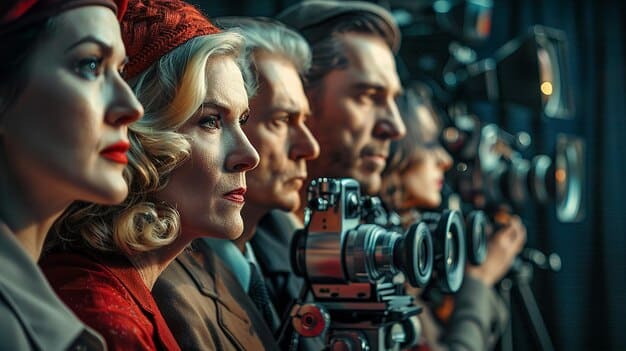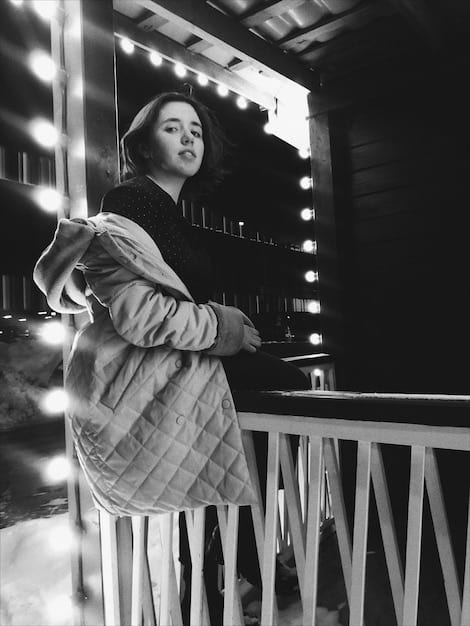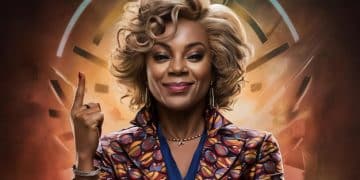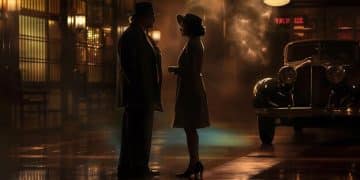The Rise of Female Directors: Hollywood’s Breaking Barriers

The rise of the female director in Hollywood signifies a pivotal shift, dismantling long-standing barriers and creating space for diverse narratives and perspectives that resonate with broader audiences.
Hollywood is undergoing a significant transformation as **the rise of the female director: breaking barriers in Hollywood** reshapes the industry, offering refreshing perspectives and challenging traditional norms.
Hollywood’s doors are opening wider to women, enriching cinema with new voices.
The Evolution of Women in Hollywood
The journey of women in Hollywood has been marked by significant challenges and triumphs. From early pioneers to contemporary filmmakers, women have fought for recognition and equal opportunities in a male-dominated industry.
Early Pioneers: Breaking Ground
These women defied societal expectations and paved the way for future generations.
- Alice Guy-Blaché: A French filmmaker, considered one of the first narrative filmmakers.
- Dorothy Arzner: The sole female director working in Hollywood during the Golden Age.
- Ida Lupino: One of the first women to direct noir films.
The Struggle for Recognition
Despite their talent and vision, female directors often faced discrimination and were relegated to smaller projects or less prestigious genres.

Despite facing numerous obstacles, these pioneers persevered, creating a lasting legacy and inspiring future generations of female filmmakers.
Key Factors Driving the Change
Several factors have contributed to the increasing prominence of female directors in Hollywood in recent years. From social movements to industry initiatives, the landscape is shifting to be more inclusive and equitable.
Social Movements and Advocacy
Movements like #MeToo and Time’s Up have raised awareness about gender inequality and sexual harassment in the entertainment industry.
- Increased Awareness: These movements brought widespread media attention to the issue.
- Demand for Accountability: Inspired a push for greater accountability within the industry.
- Support Networks: Fostered solidarity among women in film.
Industry Initiatives and Programs
Various organizations and programs have emerged to support and promote female filmmakers.
The Power of Representation
One of the most significant drivers of change has been the increasing demand for diverse stories and perspectives on screen. Audiences are craving narratives that reflect the complexities of the world we live in, and female directors are uniquely positioned to deliver these stories.
These initiatives and programs play a crucial role in nurturing female talent, providing resources, and creating pathways for women to succeed in Hollywood.
Spotlight on Accomplished Female Directors
In recent years, a number of female directors have achieved critical and commercial success, demonstrating the power and potential of women behind the camera.
Greta Gerwig
With films like “Lady Bird” and “Little Women,” Gerwig has established herself as a distinctive voice in American cinema, known for her witty dialogue, insightful character studies, and masterful storytelling.
Chloé Zhao
Zhao made history as the first woman of color to win the Academy Award for Best Director for her work on “Nomadland.”
Ava DuVernay
DuVernay has directed acclaimed films such as “Selma” and “A Wrinkle in Time,” as well as the groundbreaking documentary “13th.”

These women represent a new generation of female directors who are breaking down barriers, challenging conventions, and reshaping the landscape of Hollywood.
Challenges and Obstacles Persist
Despite the progress that has been made, female directors still face significant challenges and obstacles in Hollywood. Gender bias, lack of access to funding, and limited opportunities continue to hinder their advancement.
The Funding Gap
Female-led projects often struggle to secure funding compared to male-led projects.
Gender Bias and Stereotypes
Implicit biases and stereotypes can limit the opportunities available to female directors.
- Limited Roles: Female directors may be pigeonholed into certain genres or types of stories.
- Unequal Consideration: Their work may be judged differently than that of their male counterparts.
- Networking Barriers: They may face challenges in accessing the same networks and connections as men.
Finding Opportunities
Even with talent and experience, female directors are not afforded the same opportunities as their male counterparts.
Addressing these challenges requires ongoing efforts to promote gender equality and create a more inclusive environment in Hollywood.
The Impact on Storytelling and Representation
The rise of female directors in Hollywood is having a profound impact on storytelling and representation. By bringing diverse perspectives and experiences to the screen, women are enriching the cinematic landscape and challenging traditional narratives.
Authenticity and Nuance
Female directors often bring a unique sensitivity and understanding to stories about women, relationships, and social issues.
Challenging Stereotypes
Female directors are actively working to dismantle harmful stereotypes and create more nuanced and complex representations of female characters.
Expanding the Canon
Female directors are expanding the range of stories being told in Hollywood, offering fresh perspectives on familiar genres and introducing new voices and experiences to audiences.
By prioritizing authenticity, challenging stereotypes, and expanding the range of stories being told, female directors are reshaping the landscape of Hollywood and creating a more inclusive and representative cinematic world.
The Future of Female Directors in Hollywood
The future of female directors in Hollywood is bright, but continued progress will require ongoing advocacy, support, and commitment from all stakeholders.
Mentorship and Sponsorship
Mentorship programs and sponsorship opportunities can help emerging female directors gain access to the resources, networks, and support they need to succeed.
Inclusive Hiring Practices
Adopting inclusive hiring practices and setting concrete goals for gender representation can help ensure that women have equal opportunities to direct films and television shows.
Cultural Shift
Ultimately, creating a truly equitable and inclusive industry requires a fundamental shift in attitudes and beliefs about gender and leadership.
| Key Point | Brief Description |
|---|---|
| 🎬 Pioneers Broke Ground | Early female directors like Alice Guy-Blaché challenged norms. |
| 💪 Social Movements | #MeToo and Time’s Up raised awareness of gender inequality. |
| 🏆 Award Winners | Directors like Chloé Zhao achieved critical acclaim. |
| 💰 Funding Still a Hurdle | Female-led projects often struggle to secure funding. |
Frequently Asked Questions
▼
Alice Guy-Blaché, a French filmmaker, is considered one of the first to make narrative films. She directed, produced, and wrote numerous movies.
▼
Movements like #MeToo and Time’s Up significantly enhanced awareness of gender inequality within the film industry.
▼
Chloé Zhao made history as the first woman of color to win the Academy Award for Best Director for “Nomadland”.
▼
Female directors still face gender bias, funding gaps, and fewer opportunities, hindering their advancement. Overcoming these systematic issues is critical.
▼
Improvements involve mentorship programs, inclusive hiring practices, and a cultural shift towards gender equality. Such changes must permeate throughout the industry.
Conclusion
The rise of the female director: breaking barriers in Hollywood signifies a profound shift in the industry, bringing diverse perspectives and challenging traditional norms. The progress made by these talented women is undeniable, enriching the cinematic landscape with fresh voices. Their success is a testament to their talent, resilience, and determination to break down barriers and create a more inclusive and equitable industry.





